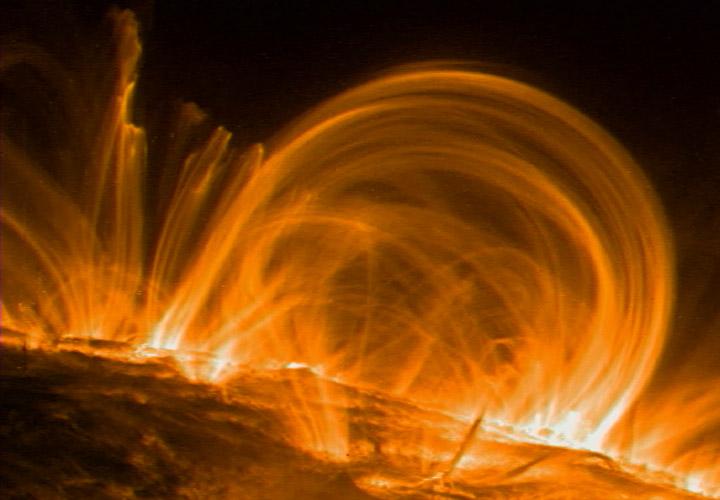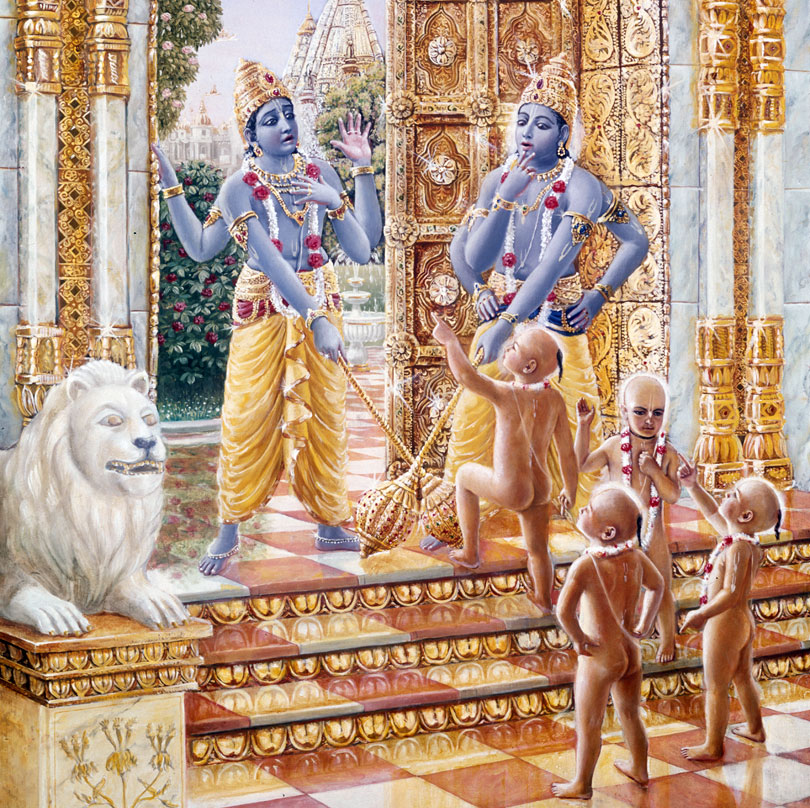Home › Forum Online Discussion › Philosophy › The Immortal Corona : Turning The Light Around
- This topic has 7 replies, 2 voices, and was last updated 7 years ago by
rideforever.
-
AuthorPosts
-
May 20, 2018 at 11:01 am #52512
rideforever
ParticipantThe Source sends out sunbeams … and that is what a human is, a sunbeam.
The beam lasts for 100 years or so.
Unless …. unless it turns back to its maker, and by repeatedly turning back, feeling the source, surrendering to the source.
Then it becomes a Corona, a loop, and so is immortal.
As the energy flows into us, we flow back into it.
It is no longer dependant on the body.
 May 24, 2018 at 1:46 pm #52520
May 24, 2018 at 1:46 pm #52520c_howdy
ParticipantMyths are only of course myths, but for example in Srimad-Bhagavatam the opponents are nearest and dearest to the God.
This is especially surprising because otherwise it would seem that only bhakti towards the Godhead is important.
HOWDY
https://prabhupadabooks.com/sb


 May 24, 2018 at 1:58 pm #52521
May 24, 2018 at 1:58 pm #52521c_howdy
Participant
Hiranyakasipu wanted to become immortal, so he underwent such severe penances that the whole universe trembled. Lord Brahma had to come to pacify him “What do you want?”
Hiranyakasipu said, “I want to become immortal!”
Lord Brahma replied, “Although I have a very long duration of life, even I am not immortal, so I cannot grant you immortality.”
So although Brahma lives for trillions of years, still he has to die. Wherever you go within this material world, either in Brahma-loka or in Patala-loka, you have to die. That is the problem. Krsna says in the Bhagavad-gita, “The real problem is janma-mrtyu-jara-vyadhi: birth, death, old age, and disease.”
Hiranyakasipu wanted to solve these problems in a materialistic way, but that is not possible. When Brahma said he could not make Hiranyakasipu immortal, Hiranyakasipu tried to secure immortality by trickery. He asked Brahma to grant that he not be killed in any of these ways: by any weapon; during the day or night; on land, in water, or in the sky; inside or outside; or by any man or beast.
So Hiranyakasipu thought he was immortal. But to protect Prahlada Maharaja, Lord Nrsimhadeva killed Hiranyakasipu without violating the boons granted by Lord Brahma. Nrsimhadeva was neither man nor beast but half man, half lion. Placing Hiranyakasipu on His lap, the Lord killed him with His fingernails, on the threshhold of the demon’s palace, at dusk.
-http://www.lightofgodhead.com/2015/08/i-cannot-grant-you-immortality/
May 24, 2018 at 4:54 pm #52522c_howdy
Participanthttps://www.youtube.com/watch?v=l7tbmAuFLS8
This book is the crowning achievement of the remarkable scholar D. Dennis Hudson, bringing together the results of a lifetime of interdisciplinary study of south Indian Hinduism. The book is a finely detailed examination of a virtually unstudied Tamil Hindu temple, the Vaikuntha Perumal (ca. 770 C.E.). Hudson offers a sustained reading of the temple as a coherent, organized, minutely conceptualized mandala. Its iconography and structure can be understood in the light of a ten-stanza poem by the Alvar poet Tirumangai, and of the Bhagavata Purana and other major religious texts, even as it in turn illuminates the meanings of those texts. Hudson takes the reader step by step on a tour of the temple, telling the stories suggested by each of the 56 sculpted panels and showing how their relationship to one another brings out layers of meaning. He correlates the stories with stages in the spiritual growth of the king through the complex rituals that formed a crucial dimension of the religion. The result is a tapestry of interpretation that brings to life the richness of spiritual understanding embodied in the temple. Hudsons underlying assumption is that the temple itself constitutes a summa theologica for the Pancharatra doctrines in the Bhagavata tradition centered on Krishna as it had developed through the eighth century. This tradition was already ancient and had spread widely across South Asia and into Southeast Asia. By interweaving history with artistic, liturgical, and textual interpretation, Hudson makes a remarkable contribution to our understanding of an Indian religious and cultural tradition.
May 24, 2018 at 5:12 pm #52523c_howdy
Participanthttps://www.youtube.com/watch?v=h4WeFznUIQo
-https://en.wikipedia.org/wiki/Brahma_Samhita
The Brahma Saṁhitā is a Sanskrit Pañcarātra text, composed of verses of prayer spoken by Brahma glorifying the supreme Lord Kṛṣṇa or Govinda at the beginning of creation. It is revered within Gauḍiya Vaiṣṇavism, whose 16th-century founder, Caitanya Mahāprabhu (1486–1534), rediscovered a part of the work, the 62 verses of Chapter 5, which had previously been lost for a few centuries, at the Adikeshav Temple in Thiruvattar, Tamil Nadu, South India.
 May 24, 2018 at 5:44 pm #52524
May 24, 2018 at 5:44 pm #52524rideforever
ParticipantMay 24, 2018 at 8:23 pm #52525c_howdy
Participant…who is very much fond of wealth and sex life…
With these two asuras gold has same reference as the Chinese alchemical tradition.
Sorry for my broken English.
HOWDY
-https://en.wikipedia.org/wiki/Hiranyaksha
Hiranyaksha (Sanskrit: हिरण्याक्ष, “golden-eyed”) was an oppressive demon asura who attacked the heavens, thereafter kidnapped and attempted to destroy goddess earth in Hindu mythology.
-https://en.wikipedia.org/wiki/Hiranyakashipu
Hiranyakashipu (Sanskrit: हिरण्यकशिपु, “clothed in gold”; the name is said to depict one who is very much fond of wealth and sex life: hiranya “gold,” kashipu “soft cushion”) is an Asura from the Puranic scriptures of Hinduism. Hiranyakashipu’s younger brother, Hiranyaksha was slain by Varaha, one of the Avatars of Vishnu. Angered by this, Hiranyakashipu decided to gain magical powers by performing a penance for Lord Brahma. He was subsequently killed by the Narasimha Avatara of Lord Vishnu. His tale depicts the futility of desiring power over others and the strength of God’s protection over his fully surrendered devotees (in the case of his son Prahlada).
-http://www.goldenelixir.com/publications/eot_jindan.html
Modern studies usually refer to the Chinese arts of the elixirs as *Waidan (External Alchemy) or *Neidan (Internal Alchemy), but the authors of alchemical texts often call their tradition the Way of the Golden Elixir (jindan zhi dao). Gold (jin) represents the state of constancy and immutability beyond the change and transiency that characterize the manifested world. As for dan, or “elixir,” lexical analysis shows that the semantic field of this term — which commonly denotes a variety of red — evolves from a root-meaning of “essence,” and that its connotations include the reality, principle, or true nature of an entity, or its most basic and significant element, quality, or property.
-https://en.wikipedia.org/wiki/History_of_metallurgy_in_the_Indian_subcontinent
The deepest gold mines of the Ancient world were found in the Maski region in Karnataka. There were ancient silver mines in northwest India. Dated to the middle of the 1st millennium BCE. gold and silver were also used for making utensils for the royal family and nobilities.the royal family wore costly fabrics so it may be assumed that gold and silver were beaten into thin fibres and embroidered or woven into fabrics or dress.
 May 25, 2018 at 7:11 am #52528
May 25, 2018 at 7:11 am #52528rideforever
Participant -
AuthorPosts
- You must be logged in to reply to this topic.
